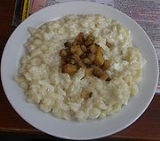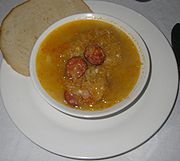
Slovak cuisine
Encyclopedia




Slovak dishes
- HaluškyHaluškyHalušky are a traditional variety of thick, soft noodles or dumplings cooked in the Central and Eastern European cuisines .They are irregular in shape...
- Bryndzové haluškyBryndzové haluškyBryndzové Halušky is one of the national dishes in Slovakia. This hearty meal consists of Halušky and bryndza , optionally sprinkled with cooked bits of smoked pork fat/bacon.Žinčica is traditionally drunk with this meal...
(potato dumplings with bryndzaBryndzaBryndza is a sheep milk cheese made in Central and Eastern Europe. Recipes differ slightly across the countries.-Etymology:Brânză or brînză is the generic word for "cheese" in Romanian, there is no special type of cheese associated with it...
- a sheep's-milk cheese) - StrapačkyStrapackyStrapačky is a Slovak dish, similar to bryndzové halušky where the base compound of the dish is halušky , however instead of bryndza, stewed sauerkraut is used....
- Chľustačky
- Bryndzové halušky
- Lokše (pancakes made of potato-dough baked directly on the stove)
- Bryndzové pirohyPierogiPierogi are dumplings of unleavened dough - first boiled, then they are baked or fried usually in butter with onions - traditionally stuffed with potato filling, sauerkraut, ground meat, cheese, or fruit...
- Parené buchty (steamed jam-filled dumplings topped with poppy seeds or nuts)
- Široké rezance s tvarohom a slaninou: tagliatelleTagliatelleTagliatelle and tagliolini are a traditional type of pasta from Emilia-Romagna and Marches, regions of Italy. Individual pieces of tagliatelle are long, flat ribbons that are similar in shape to fettuccine and are typically about 0.65 cm to 1 cm wide...
with quarkQuark (cheese)Quark is a type of fresh cheese, also known as tvorog , topfen , biezpiens , and varškė . It is made by warming soured milk until the desired degree of denaturation of milk proteins is met, and then strained...
(farmer's cheese) and fried baconBaconBacon is a cured meat prepared from a pig. It is first cured using large quantities of salt, either in a brine or in a dry packing; the result is fresh bacon . Fresh bacon may then be further dried for weeks or months in cold air, boiled, or smoked. Fresh and dried bacon must be cooked before eating... - Zemiakové placky (potato pancakes fried in oil), also called Haruľa in regions Horehronie, Pohronie, Kysuce and Orava
- Žemľovka (bread pudding)
- Granadír or Granadírsky pochod, also known as Grenadír marš
- Ryžový nákyp (rice pudding)
- Orechovník, a sweet Nut rollNut rollA nut roll is a pastry consisting of a sweet yeast dough that is rolled out very thin, spread with a nut paste made from ground nuts and a sweetener like honey, then rolled up into a log shape. This 'log' is either left long and straight or is often bent into a horseshoe shape, egg washed, baked,...
- Makovník (poppy seed roll)
- Bratislavské rožteky
- Segedin Goulash (pork stew with sauerkraut and cream or sour cream, usually served with steamed dumplings (knedľa).
- Rezeň (breaded pork schnitzel)
Soups and sauces
- Fazuľová (soup made of beans)
- Kapustnica (soup made of sauerkrautSauerkrautSauerkraut , directly translated from German: "sour cabbage", is finely shredded cabbage that has been fermented by various lactic acid bacteria, including Leuconostoc, Lactobacillus, and Pediococcus. It has a long shelf-life and a distinctive sour flavor, both of which result from the lactic acid...
) - Rezancová (chicken soup with noodles)
Meat
PorkPork
Pork is the culinary name for meat from the domestic pig , which is eaten in many countries. It is one of the most commonly consumed meats worldwide, with evidence of pig husbandry dating back to 5000 BC....
, beef
Beef
Beef is the culinary name for meat from bovines, especially domestic cattle. Beef can be harvested from cows, bulls, heifers or steers. It is one of the principal meats used in the cuisine of the Middle East , Australia, Argentina, Brazil, Europe and the United States, and is also important in...
and poultry
Poultry
Poultry are domesticated birds kept by humans for the purpose of producing eggs, meat, and/or feathers. These most typically are members of the superorder Galloanserae , especially the order Galliformes and the family Anatidae , commonly known as "waterfowl"...
are the main meats consumed in Slovakia, with pork being the most popular by a substantial margin. Among poultry, chicken is most common, although duck, goose, and turkey are also well established. A blood sausage called jaternice also has a following, containing any and all parts of a butchered pig; it is an acquired taste. Game meats, especially boar, rabbit, and venison, are also widely available throughout the year. Lamb and goat are also available, but for the most part are not very popular. The consumption of horse meat is generally frowned upon.
Grilled meat is not common in Slovakia. Instead, meat is either breaded and fried in oil (schnitzel), or is cooked and served in sauce. Hungarian influences in Slovak cuisine can be seen in popular stews and goulashes. However, these have been given Slovak touches. Chicken paprikash is typically served with halušky and Hungarian goulash (spicy beef stew) is served with slices of a large bread-like steamed dumpling.
Traditional sweets and cookies
Usually baked at Christmas time, but also all year long, Slovak traditional sweets are usually home baked and harder to find in stores.- Laskonky: fluffy dough with walnuts and creamy filling
- Mačacie oči
- Trotle: 2 layers of cookie-like round tarts filled with chocolate cream and half-dipped in dark chocolate.
- Vajcový koňak: the equivalent of eggnogEggnogEggnog, or egg nog, is a sweetened dairy-based beverage traditionally made with milk and/or cream, sugar, beaten eggs , and liquor...
. - Medovníčky
- Medvedie labky
- TrdelnikTrdelníkTrdelník is a traditional cake and sweet pastry, from the Slovak town of Skalica. It is made from rolled dough, wrapped around a stick then grilled and topped with sugar and walnut mix.- History :Its production has a long tradition in Skalica...
or Skalický trdelnik, a traditional cake baked on a rotating spit over open fire - Haboše
- Čeregi
- Makové pupáky
Eating habits
Traditionally the main meal of the day is lunch, eaten around noon. However, changing work routine has altered this in the recent decades; today, it is not uncommon for many SlovaksSlovaks
The Slovaks, Slovak people, or Slovakians are a West Slavic people that primarily inhabit Slovakia and speak the Slovak language, which is closely related to the Czech language.Most Slovaks today live within the borders of the independent Slovakia...
to eat their main meal in the evening. Lunch in Slovakia
Slovakia
The Slovak Republic is a landlocked state in Central Europe. It has a population of over five million and an area of about . Slovakia is bordered by the Czech Republic and Austria to the west, Poland to the north, Ukraine to the east and Hungary to the south...
usually consists of soup AND a main meal. It's customary in Slovakia
Slovakia
The Slovak Republic is a landlocked state in Central Europe. It has a population of over five million and an area of about . Slovakia is bordered by the Czech Republic and Austria to the west, Poland to the north, Ukraine to the east and Hungary to the south...
to bring a bottle of wine or other alcohol as a gift if you are invited to visit someone's home.
See also
- Cuisines of the worldCuisineCuisine is a characteristic style of cooking practices and traditions, often associated with a specific culture. Cuisines are often named after the geographic areas or regions that they originate from...
- List of recipes

